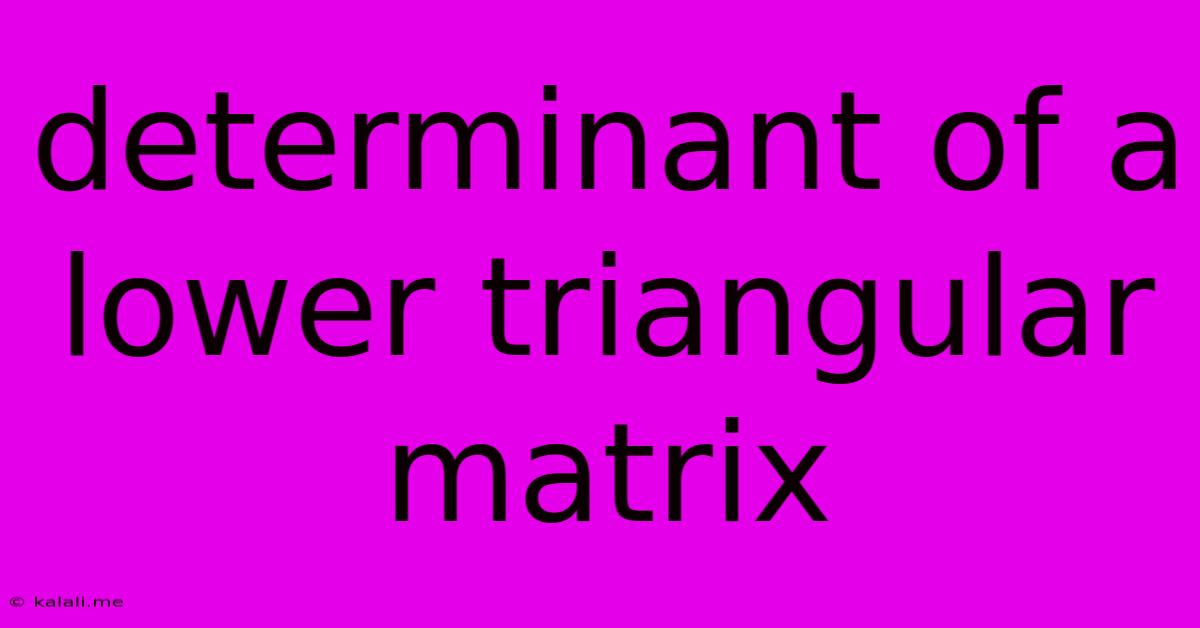Determinant Of A Lower Triangular Matrix
Kalali
Jun 13, 2025 · 3 min read

Table of Contents
Determinant of a Lower Triangular Matrix: A Comprehensive Guide
Meta Description: Learn how to efficiently calculate the determinant of a lower triangular matrix. This guide provides a clear explanation, examples, and explores the underlying mathematical principles. Understanding this simplifies linear algebra significantly.
The determinant of a matrix is a fundamental concept in linear algebra with wide-ranging applications in various fields. While calculating the determinant of a general matrix can be computationally intensive, certain matrix types offer significant shortcuts. One such type is the lower triangular matrix. This article will explore the efficient method for calculating the determinant of a lower triangular matrix and delve into the reasons behind this simplification.
What is a Lower Triangular Matrix?
A lower triangular matrix is a square matrix where all the entries above the main diagonal are zero. The main diagonal runs from the top-left to the bottom-right corner of the matrix. For example:
| a 0 0 |
| b c 0 |
| d e f |
In this example, a, c, and f are on the main diagonal, and all entries above them are zero. The values b, d, and e can be any number.
Calculating the Determinant of a Lower Triangular Matrix
The beauty of a lower triangular matrix lies in its simple determinant calculation. The determinant of a lower triangular matrix is simply the product of its diagonal elements. This significantly reduces the computational complexity compared to the general determinant calculation methods like cofactor expansion or Gaussian elimination.
Let's consider the example above:
The determinant of the matrix is: det(A) = a * c * f
This rule holds true for any size lower triangular matrix. Whether it's a 2x2, 3x3, or a larger n x n matrix, the determinant is always the product of the diagonal entries.
Why does this work?
This simplification stems from the properties of determinants and how they behave under elementary row operations. The process of calculating a determinant using cofactor expansion involves recursively breaking down the matrix into smaller submatrices. In a lower triangular matrix, this recursive process quickly simplifies because the cofactors above the main diagonal are always zero (due to the zero entries). This leads to a direct computation involving only the diagonal elements.
Example: Finding the Determinant
Let's consider a 3x3 lower triangular matrix:
A = | 2 0 0 |
| 1 3 0 |
| 4 5 6 |
The determinant of A is:
det(A) = 2 * 3 * 6 = 36
This calculation is significantly faster than using the general determinant formula, especially for larger matrices.
Applications of Lower Triangular Matrices and their Determinants
Lower triangular matrices and their determinants find applications in various areas, including:
- Linear Algebra: Solving systems of linear equations (using LU decomposition).
- Numerical Analysis: Algorithms for matrix factorization and solving eigenvalue problems.
- Computer Graphics: Transformations and projections.
- Physics and Engineering: Modeling and solving systems of differential equations.
Conclusion
Calculating the determinant of a lower triangular matrix is a straightforward process. Understanding this property not only simplifies calculations but also provides a valuable tool in various mathematical and computational applications. The product of the diagonal elements directly provides the determinant, offering an efficient shortcut compared to more general determinant calculation methods. Mastering this technique is essential for anyone working with linear algebra and its related applications.
Latest Posts
Latest Posts
-
Which Of The Following Is An Inert Gas
Jun 14, 2025
-
Prime Numbers From 1 To 30
Jun 14, 2025
-
How Far Is Singapore From Equator
Jun 14, 2025
-
How Many Watts Equal 1 Horsepower
Jun 14, 2025
-
Snake In The Grass Meaning Idiom
Jun 14, 2025
Related Post
Thank you for visiting our website which covers about Determinant Of A Lower Triangular Matrix . We hope the information provided has been useful to you. Feel free to contact us if you have any questions or need further assistance. See you next time and don't miss to bookmark.